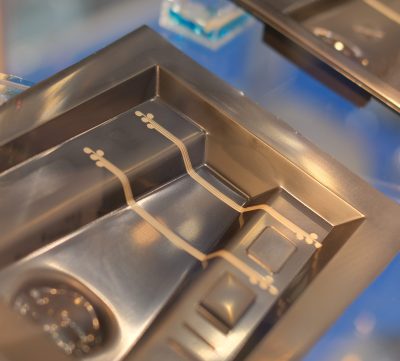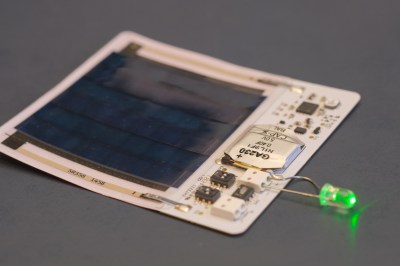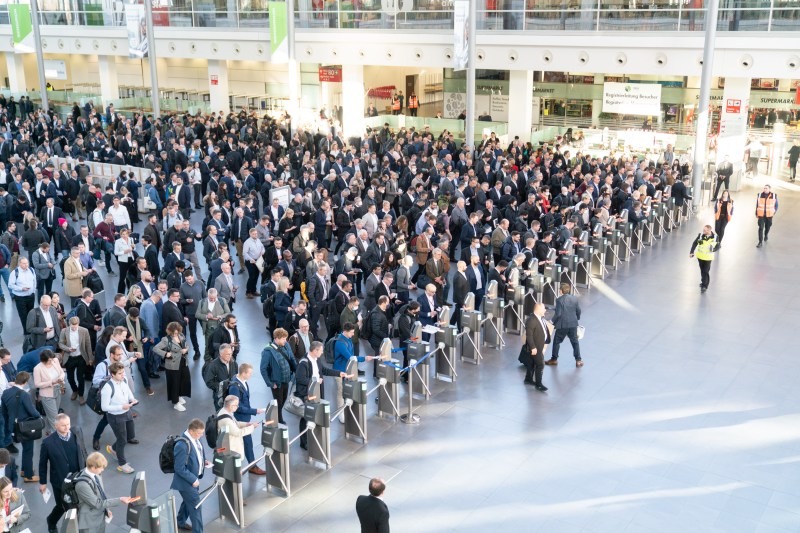Last week, the world’s largest electronics trade fair took place in Munich, so I had to attend. Electronica is so big that it happens only once every two years and fills up 14 airplane hangars. As the fairly generic name suggests, it covers anything and everything having to do with electronics. From the producers of your favorite MLCC capacitors to the firms that deliver them to your doorstep, from suppliers of ASIC test equipment to the little shop that’ll custom wind toroids for you, that’s a pretty wide scope. Walking around, I saw tomorrow’s technology today from the big players, but I also picked up some ideas that would be useful for the home gamer.
 When I first walked in, for instance, I ran into the Elantas booth. They’re a company that makes flexible insulation and specialty industrial coatings. But what caught my eye was a thermoformed plastic sheet with circuit traces on it. To manufacture them, they cut out copper foil, glue it to a flat plastic sheet with a glue that has a little give, and then put it all together into a vacuum former. The result is a 3D circuit and organically formed substrate in one shot. Very cool, and none of the tech for doing that is outside of the reach of the determined hacker.
When I first walked in, for instance, I ran into the Elantas booth. They’re a company that makes flexible insulation and specialty industrial coatings. But what caught my eye was a thermoformed plastic sheet with circuit traces on it. To manufacture them, they cut out copper foil, glue it to a flat plastic sheet with a glue that has a little give, and then put it all together into a vacuum former. The result is a 3D circuit and organically formed substrate in one shot. Very cool, and none of the tech for doing that is outside of the reach of the determined hacker.
The Cool Stuff
All of the stands, big or small, try to lure you in with some gimmick. The big fish, firms with deep pockets, put up huge signs and open bars, and are staffed by no shortage of salespeople in suits. The little fish, on the other hand, have to resort to showing you the cool stuff that they do, and it’s more often the application engineers sitting there, ready to talk tech. You can guess which I found more interesting.
For instance when I walked up to an obviously DIY popcorn popper that was also showing 5000 FPS footage of kernels in mid-pop, I had to ask. The company in question was a small UK outfit that made custom programmable power supplies and digital acquisition gear that interfaced with it. You could plug in their box to some temperature probes, fire off the high-speed video camera, and control the heating and cooling profile without writing any code. Very sweet.
The engineer who designed the demo was also running it, and we got into a long discussion of just how you measure the temperature anyway. He had one thermocouple on the converted heat-gun, one in the popcorn kernels, and one on the other side. He was triggering the camera off of the kernels, but there was this strange temperature anomaly in the logs of the post-kernel temperature, because popped popcorn releases steam, and at the same time is a good insulator. I love this kind of attention to crazy details, and I roast my own coffee in a very similar setup, so I sympathize.
I got into really interesting discussions with an engineer who designed custom chip-testing rigs. While they were mostly designing for lower voltages and currents, he told tales of implausibly small test pins that would nonetheless carry tens of amps.
A company that makes power electronics and test equipment sponsored the solar-electric vehicle team from RWTH Aachen, and they had their vehicle there to look at along with a university student who worked on the project. I must have spent half an hour talking with him about all of the little details that went into the design of their World Solar Challenge contending car. Most everything is hand-made on the vehicle, from the ultra-lightweight carbon fiber frame to the single-board computer that records all of the data and relays it to the chase van, as well as serving as a communication channel for the driver. The name of the game in solar cars is aerodynamics, and the car has fenders that fit the wheels with about 5 mm clearance, a wing-shaped solar panel, and three wheels to absolutely minimize the amount of air displaced. It had shark-skin tape on the sides, and when I asked about the coefficient of drag, he said it was a secret but that it started with a zero after the decimal point, even after rounding. Yowza.
One company was making haptic actuator modules for use in automotive applications, for instance. Basically, you couple a capacitive sensor strip on the back side of a plastic moulding with their product – a small magnetic speaker-like device – and it vibrates when you press it. The effect is much like the haptic vibration on pressing the cell phone screen. But the idea of using a small speaker coil to do what you would normally do with a spinning weight was interesting.
Finally, I’ll admit to having spent way too much time in the testing and automation sections, with not enough hacker-friendly takeaways to warrant it. But it’s just so cool to watch real-time BGA X-ray inspection machines, high-speed pick-and-place, or PCB-testing robots do their thing.
The Next Stuff
MicroLED displays are the new hotness. Of the displays, by far the most impressive was a 114 DPI screen at the Tianma booth. I don’t know anything about pricing or availability, and if you have to ask you probably can’t afford it. I’m also not exactly sure what the point is. They had them configured as HUDs for automotive applications, but it loses the virtue of a dedicated HUD that the focus it out near infinity. But as far as the tech goes, they looked very very cool. I bumped into [Mike Harrison] of Mike’s Electric Stuff fame, and he was wondering if he could get them into an art project.
Organic solar cells were entirely new to me, but I bumped into them twice at Electronica. First off, I encountered Dracula Technologies. (Nice name!) They make inkjet-printable organic solar cells, and can thus customize the cell shape. Unfortunately, they are aimed at custom production runs for now. Again, if you have to ask…
Later, I stopped by the Epishine booth, which was displaying similar organic solar cells, but in a roll-to-roll process that turns them out in traditional squares. Off-the-shelf squares aren’t as sexy as custom shapes, but the advantage is that you can buy them right now. We might wait until the price comes down a little bit as they ramp up production, but they handed me an evaluation kit and it’s pretty cool, charging up a 0.4 F supercap in about four hours in my brightly lit mid-day office.

Both of these organic solar technologies are on very thin and flexible plastic substrates, and both are tuned to optimally harvest the amounts of light that you commonly find inside. This video explainer is pretty good. Since the target is ambient indoor lighting, these cells produce microwatts rather than megawatts, but if you are looking to deploy a small sensor device indoors with a low duty cycle, something like this could be just the ticket.
Or you could drive an ultra low power display. On the way out, I ran by ynvisible, a company that makes displays using polymer electrochromic inks, coincidentally in the same factory as Epishine. The result is something like low contrast and slow-to-refresh e-ink, but on a much thinner substrate and using nanowatts. Because the displays are screen-printed, setup costs for custom displays are also supposedly affordable. Talking to one of the engineers, he mentioned that the tech should be DIYable. Anyone know more about electrochromic polymers? I love the way they fade in and out.
The Weird Stuff: Capacitors at the Beach
Put yourself in different shoes for a minute. You run a factory that manufactures resistors, weaves wiring harnesses, or winds toroidal transformers. What are you going to do for eye-candy at the big trade fair? How are you going to arrange those crimp connectors to draw foot traffic? I’m always amused by the clever and absurd displays put on by the makers of the less sexy electronics. So here’s a tribute to what I call “Capacitors at the Beach”, both from 2022 and from 2018.
Electronica 2024
I made my best effort, and still there were corners of the show that I never visited and people I didn’t see because I was only there two days. It’s a big show, and it turned my brain to mush and put blisters on my feet. But it was worth it. If you’re able to make one, you absolutely should.
Featured image of the crowd, and thumbnail of David Hasselhoff by Markus Brönner, copyright Messe München














































“Hasselhoff at the Beach” was a beer can pyramid. Those Germans sure do love David Hasselhoff. RIP, Norm.
Have you ever heard any German pop music?
They listen to Hasselhoff because it’s better. Even Abba is better.
They should stick to Polka.
Avoid Berlin during ‘Disco Week’ at all costs. It truly sucks big wet donkey balls.
Polka!? Hmmm… could it be that you are confusing two different European nations? ;-)
Yeah, but was there any swag??
There was! A lot of it involved standing in lines, though, and I passed on essentially all of that stuff, because no time.
Still, I’m happier with a couple cool dev kits than I am with yet another PCB-manufacturer’s stress ball.
Was that picture from this year’s show? Nobody even wearing a mask, yikes!
In my hometown there is now a pilot with surgeons that are covid positive to perform operations, fun times in Europe!
Thaat: Good! I’d rather catch covid from a surgeon than not get surgery I needed. We’ve all learnt how stupid it is to stop the world because of a cough, Sweden are laughing at how everywhere else has destroyed their economies and liberties.
I don’t think they’re trying to infect you via surgery. I think they’re saying if you’re sick with COVID, let docs similarly infected work on you? It’s not like they’re gonna give you something you don’t already have?
And nice show of ignorance there buddy. It’s not COVID itself killed from a “cough”, it caused pneumonia and suffocated you basically…
Everyone in Sweden except the seniors who died without oxygen or morphine…. And overall they didn’t do as well compared to the neighbouring countries.
Where data collection is allowed about 2% of the population has Covid-19 at any given time, mostly asymptomatic.
It’s over. Just a cold to an educated immune system.
Getting power grubbers to give up power once taken is hard.
The nations that did the hardest lockdowns are now the ones most screwed. Because their citizens only have vaccine based immunity.
And in the case of China, their vaccine wasn’t even that good! Hard to imagine how rolling lockdowns eventually end in China!
Looks like we found another antivaxxer. The lockdowns helped stop people from overloading hospitals, and now that we have vaccines, people can survive even the varients because the vaccine confers at least a partial sort of protection…
Difference between antivaxxer and ‘lockdowns forever’. We’ve clearly passed the need for boosters and masks.
Would you prefer data wasn’t collected? Too bad your government isn’t global. So sad.
+1
I get a drug every six months that costs at least $10,000 per session. It’s a tad cheaper now that there’s a generic.
Statistics say I’d be dead by now without the drug. It’s a rare disease. Likely no drugs aimed at the disease, the one I get is used for rheumatoid arthritis, kidney transplants, and some leukemia.
Because the drug greatly diminishes my immune system, the vaccine doesn’t do.much for me. There’s Evusheld for people like me, but I hear it’s less effective for the variants, and there’s doubt that money will be spent for an upgrade.
The expensive drug isn’t temporary. Three years so far, and it’s for life.
It is Germany. Wearing musk is voluntary with exception of public transport, medical centers and elder home. Most of other EU countries drooped the “mandatory” mask all together, but nobody will look at you weird for wearing one.
Also it is Europe, so most of people are 2-3 shot and up to 2 times got it. People just stopped caring. We really need some research to target and prove heard immunity over lowering symptoms since people care more about appearance of solidarity than their own health then risk/inconvenience of getting yet another shot(also dropping patents on vaccine made by subsidized reasarch would make it long way in proving this is not just a money grab).
Why would they be? Anyone that concerned with getting sick probably shouldn’t be going to a massive convention.
LOL. Our country have not had mask restrictions since February. And yes, our stats are still quite good because we also have almost all of the population vaccinated (now for the fourth time).
Aw man, I missed so much cool stuff! Hopefully I can go to 2024 too.
Well … if you’ve got capacitors at the beach, you’ve just GOT to have David Hasselhoff, yes? THIS article (and others like it) are why I still read Hackaday and listen to the podcast.
I don’t know if it’s only my feeling, but it looked like there was a lot less stuff targeting hobbyists/makers/hackers than during the last 2018 edition.
Blockchain buzzword has gone silent, the IoT hype has come down to something reasonable, and the new vaporware seems to be SiC/GaN. As usual, it’s a serious thing for some, and some others only do it as a side business with various prototypes to avoid appearing like dinosaurs stuck to Si.
It’s surprising to see that big players like Intel, Microchip or Nvidia did not even have a booth this year, and nobody was giving EVKs anymore (obvious considering how some of those chips are hard to find). It’s not necessarily a bad thing, but it looks like targets are changing.
I didn’t get to take any pictures b/c I was too busy talking to folks (my bad!) but the Elektor booth had a hardware-startups contest where they had invited innovative young companies.
(Among them Stephen Hawes’ Opulo. Got to see a Lumen PnP in real life, which was cool.)
But that was really the only hacker/maker scene that I saw. I think the cost of a booth means that you’re not footing the bill unless you’re already pretty well established. Again, kudos to Elektor for offering the booth space for free to the various startups that they invited.
Among the rest, there _were_ some very cool small companies, though. But they were all further along from being just a few hackers.
Half of the industry is still “IoT” and “in the cloud”, while the other half has already flipped back: “compute on the edge”. Make up your minds!
Hello Michael, uh I mean David… Dont you think it is time to retire your lackluster career? We both know who the real star was in the television series that made you famous. And I have always been desired by more fans than you ever will. Do you really think people watched Baywatch to see you running along the beach Michael? Ah, pretty sure that is a no!
Regards,
KITT